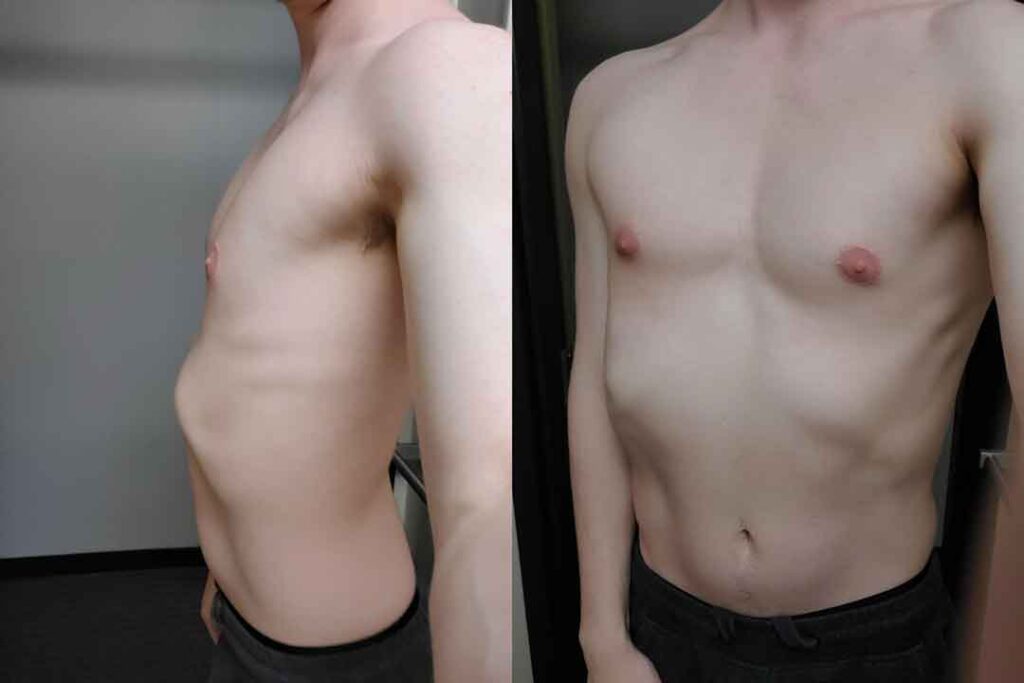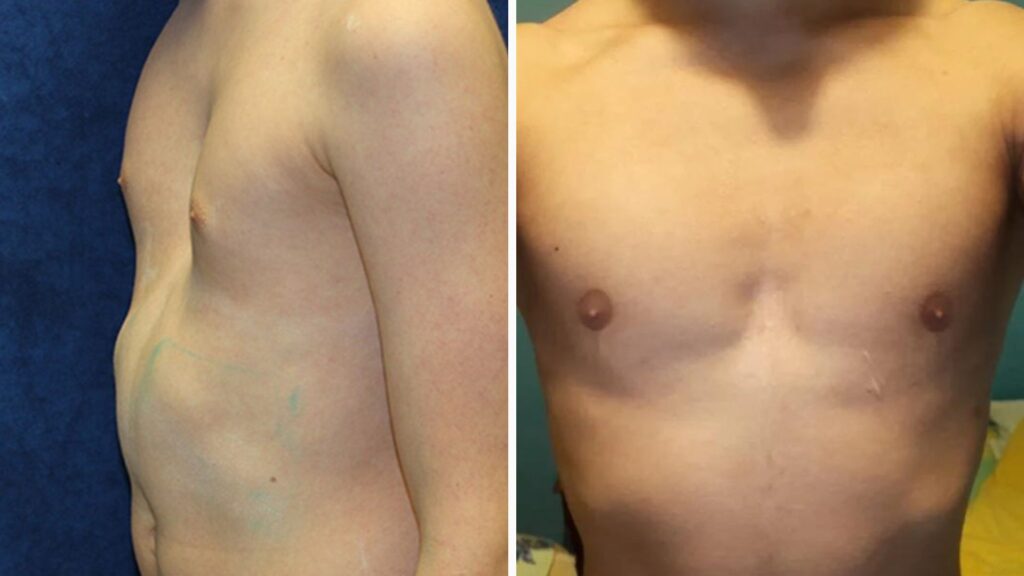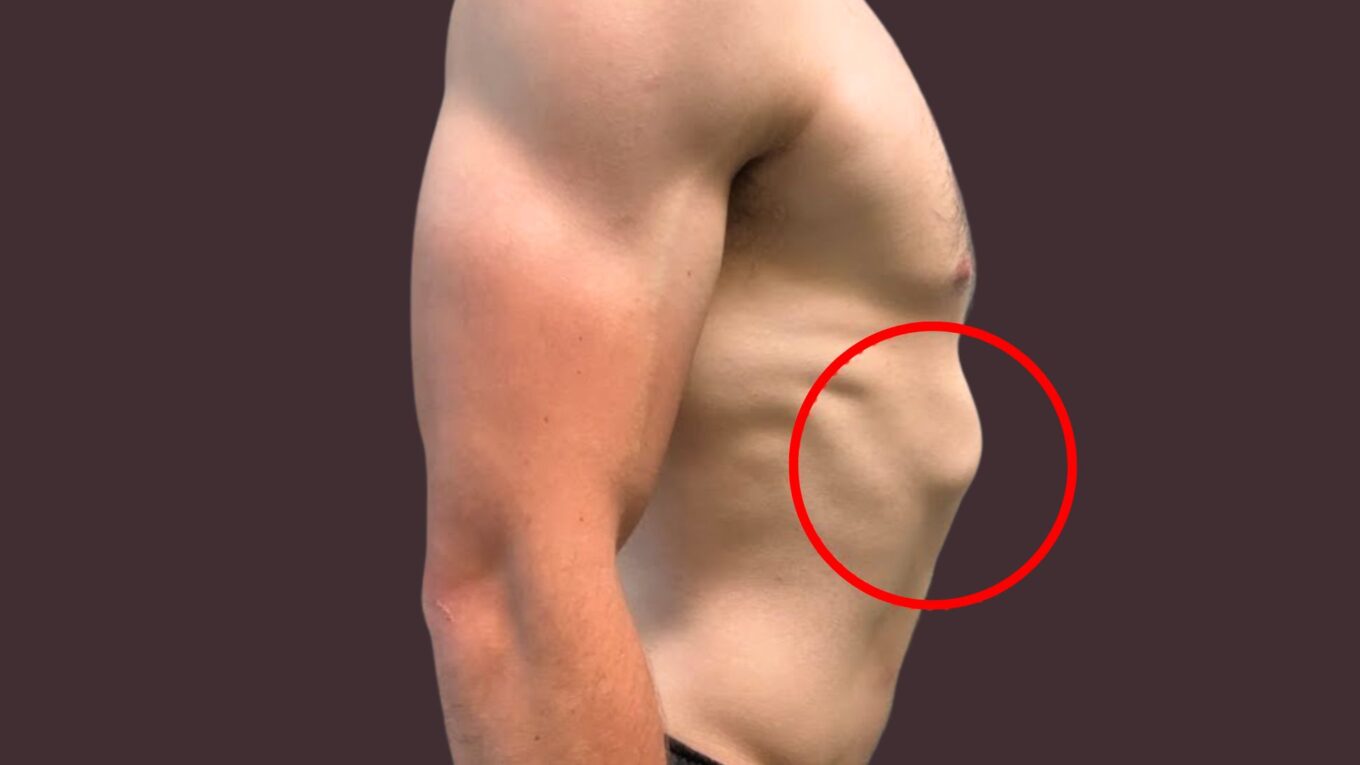Have you ever noticed your lower ribs protruding outward, creating an uneven appearance in your chest or back?
Flared ribs can cause discomfort and affect posture. While various factors contribute to this issue, there are ways to prevent and address it effectively.
In this blog post, we’ll explore the common causes of flared ribs and provide practical tips for keeping your rib cage in proper alignment.
By understanding the underlying reasons and implementing targeted exercises and lifestyle changes, you can take control of your rib health and improve your overall well-being.
Let’s discover how to prevent flared ribs and maintain a balanced, pain-free posture.
Understanding Rib Flare

Rib flare occurs when the lower ribs stick out more than normal, changing the body’s natural shape. You may notice a clear curve below the chest area, with the lower ribs poking out.
Common signs of rib flare include pain or discomfort in the rib area, a visible bulge, and possible trouble breathing normally.
1. Anatomy Involved
Rib flare affects several important body parts, including the ribs, ab muscles, and the spine. The ribs shield vital organs and help with breathing, while the ab muscles work to keep the rib cage and spine stable.
The spine provides support for the body’s overall structure. When these parts are not lined up correctly, or there is weakness, rib flare can result as the body tries to compensate for the imbalance.
2. Causes of Rib Flare
Poor posture is a leading cause of rib flare for many people. Slouching or spending much time hunched over can weaken the ab muscles and change the spine’s alignment, leading to flared ribs.
Certain movements, like repeated or heavy lifting, can worsen rib flare, especially if done with incorrect form.
Less often, rib flare may be due to medical issues like scoliosis, past chest or back injuries, or natural differences in bone structure and muscle growth.
Identifying Rib Flare
1. Self-Diagnosis
To see if you have rib flare, stand in front of a mirror with a relaxed posture and check if your lower ribs stick out more than your upper ribs.
Look for any unevenness in your rib cage and visible bulging when you raise your arms overhead or lie flat on your back. You can also lie down and use your hands to feel the alignment and protrusion of your ribs.
If you notice an increased curve, it could be a sign of rib flare. To help spot rib flare, pay attention to changes in your silhouette when you move your body differently.
To help you better understand how rib flare differs from other conditions with similar symptoms, the following table compares rib flare with conditions like scoliosis and chest injuries, highlighting unique symptoms and causes for each.
| Condition | Symptoms | Causes |
|---|---|---|
| Rib Flare | – Protruding lower ribs | – Poor posture |
| – Discomfort or pain in the rib area | – Repetitive or heavy lifting | |
| – Difficulty breathing (in severe cases) | – Previous injuries to the chest or back | |
| Scoliosis | – Uneven shoulders | – Genetic predispositions |
| – Sideways curvature of the spine | – Developmental issues during childhood | |
| – Rib prominence on one side | ||
| Chest Injuries | – Sharp pain at the site of injury | – Direct blow to the chest |
| – Swelling and bruising | – Falls, sports injuries, accidents | |
| – Difficulty breathing or coughing |
2. Professional Diagnosis
If self-tests point to rib flare or you have pain, discomfort, difficulty breathing, or rib protrusion, it’s best to see a doctor.
During your visit, the doctor will likely do a physical exam to assess the structure of your rib cage and ask about any recent activities or injuries that may have contributed to your symptoms.
Based on the initial assessment, the doctor may order imaging tests such as X-rays or an MRI to examine your rib alignment better and rule out other conditions.
Consequences of Unaddressed Rib Flare

1. Short-Term Impacts
People with rib flare may feel immediate discomfort, especially during activities that involve upper body movement or when lying in certain positions.
The bulging of the ribs can also be easily seen, which may lead to feeling self-conscious or upset about physical appearance.
2. Long-Term Risks
If rib flare is not addressed, it can lead to ongoing pain over time, particularly in the back and chest areas, as the body tries to compensate for the misalignment.
The changed position of the ribs can also interfere with normal breathing, potentially causing problems with taking deep breaths and reduced breathing efficiency.
Ignoring rib flare for too long can worsen overall posture, such as increased curvature and misalignment of the spine, which may result in additional muscle and bone issues.
Treating Rib Flare
1. Medical Treatments
Treatment for rib flare may involve physical therapy to build strength in the muscles around the ribs and improve posture. In more serious cases, surgery may be needed to fix rib issues.
Physical therapists can create specific exercise plans and routines focusing on the muscles affected by rib flare, helping to reduce symptoms and stop them from returning.
Surgery may be suggested for severe cases where physical therapy hasn’t worked to realign the ribs and reduce bulging.
2. Home Remedies and Exercises
Making the core muscles stronger is key to managing and preventing rib flare. Exercises like planks, bridges, and ab presses can help improve muscle tone and stabilize the ribs.
Regularly checking your posture, using furniture that supports good posture, and doing yoga or Pilates can help maintain proper alignment and lower the risks of rib flare.
Breathing exercises focusing on using the diaphragm can reinforce proper rib alignment and improve lung capacity, which can be especially helpful for people with rib flare.
To support your treatment plan and strengthen the muscles that help maintain proper rib alignment, consider incorporating the following exercises into your routine.
This table outlines each exercise, how often to perform it, and the benefits it offers for those dealing with rib flare.
| Exercise Name | Description | Frequency | Primary Benefits |
|---|---|---|---|
| Plank | Hold a prone position supported on elbows | Daily, 1-2 min | Strengthens core, reduces rib flare |
| And toes, keeping the body straight. | |||
| Bridges | Lie on your back, feet flat, and lift your hips to create a | 3 sets of 10 reps | Strengthens lower back and glutes, stabilizes |
| A straight line from shoulders to knees. | daily | the spine | |
| Abdominal Press | Lie on your back, knees bent, and push your lower back into | 3 sets of 15 reps | Strengthens abdominal muscles, helps align ribs |
| The floor by tightening abdominal muscles. | daily | ||
| Yoga (Cobra Pose) | Lie on your stomach, palms next to your shoulders, | 3-4 times a week | It improves flexibility and posture, opens the chest, and |
| Lift the chest off the floor, stretching upwards. | strengthens abdominal wall |
Real-World Success Stories
Many patients have found relief from rib flare symptoms through dedicated treatment and exercise routines. For example, Sarah, a 32-year-old office worker, experienced significant improvement in her rib flare after just six weeks of targeted physical therapy sessions and at-home exercises. “I no longer feel the constant discomfort in my rib area, and my posture has improved tremendously,” she shares.
3. Lifestyle Changes
Changing how you sit, stand, and lift things can help prevent rib flares from getting worse. Also, make sure your workspace is set up to support good posture.
Staying a healthy weight reduces pressure on the ribs and belly, lowering the risk of rib flare. A balanced diet supports muscle and bone health.
Regular check-ups with a healthcare provider can help monitor the condition and adjust treatments as needed to keep symptoms from worsening.
Preventive Measures

1. Routine Practices
Add simple exercises and stretches to your daily routine to maintain and improve core strength and flexibility. Exercises like pelvic tilts, ab bracing, and regular stretching sessions can help improve posture.
Be mindful of your posture throughout the day while standing, sitting, or moving. Regularly check and fix any slouching to prevent rib flare from developing or worsening.
Make these practices a part of your daily routine to ensure the benefits last and effectively prevent rib flare.
2. Ergonomic Adjustments
Adjust your workspace to promote good posture. Ensure the height and position of your chair, desk, and computer keep your back straight and shoulders relaxed without straining your neck or eyes.
Use supportive seating, choose mattresses that support spinal alignment, and think about using standing desks or ergonomic chairs that encourage movement and proper posture at home and in the office.
Try using ergonomic tools like lumbar supports, footrests, or orthopedic seat cushions at your desk or in your car to help maintain your spine’s natural curve and prevent rib flare.
Conclusion
Rib flare is a common postural issue that can lead to discomfort, pain, and long-term health consequences if left unaddressed.
By understanding the causes, identifying the symptoms, and implementing targeted treatments and preventive measures, you can effectively manage and prevent rib flare.
Remember, maintaining good posture, strengthening your core muscles, and making necessary lifestyle and ergonomic adjustments are key to properly aligning your rib cage.
If you experience persistent symptoms or have concerns about your rib flare, don’t hesitate to seek guidance from a healthcare professional.
Consistent effort and attention to your body’s needs can improve your posture, alleviate discomfort, and promote overall well-being.
Take charge of your rib health today and enjoy the benefits of a balanced, pain-free posture.
Frequently Asked Questions
Can You Fix Rib Flare Naturally?
Yes, rib flare can often be fixed naturally through targeted exercises, stretches, and lifestyle changes focusing on improving posture and strengthening core muscles.
Are Flared Ribs Genetic?
While certain genetic factors may influence bone structure and muscle development, rib flare is not a purely genetic condition.
Can Rib Flare Cause Digestive Issues?
In some cases, severe rib flare may pressure the digestive organs, potentially contributing to discomfort or digestive issues. However, this is not a common occurrence.




